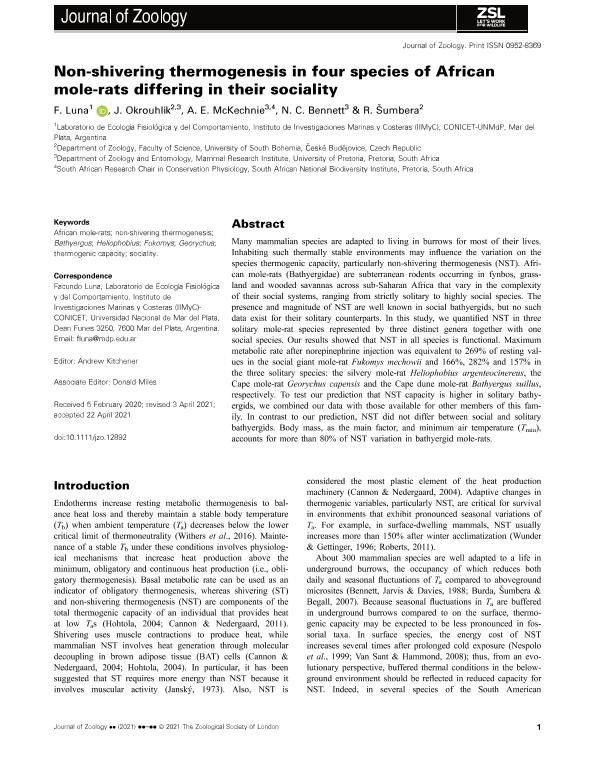Mostrar el registro sencillo del ítem
dc.contributor.author
Luna, Facundo

dc.contributor.author
Okrouhlík, J.
dc.contributor.author
McKechnie, A. E.
dc.contributor.author
Bennett, N. C.
dc.contributor.author
Sumbera, Radim

dc.date.available
2022-09-08T12:05:32Z
dc.date.issued
2021-09
dc.identifier.citation
Luna, Facundo; Okrouhlík, J.; McKechnie, A. E.; Bennett, N. C.; Sumbera, Radim; Non-shivering thermogenesis in four species of African mole-rats differing in their sociality; Wiley Blackwell Publishing, Inc; Journal Of Zoology; 315; 1; 9-2021; 58-68
dc.identifier.issn
0952-8369
dc.identifier.uri
http://hdl.handle.net/11336/167874
dc.description.abstract
Many mammalian species are adapted to living in burrows for most of their lives. Inhabiting such thermally stable environments may influence the variation on the species thermogenic capacity, particularly non-shivering thermogenesis (NST). African mole-rats (Bathyergidae) are subterranean rodents occurring in fynbos, grassland and wooded savannas across sub-Saharan Africa that vary in the complexity of their social systems, ranging from strictly solitary to highly social species. The presence and magnitude of NST are well known in social bathyergids, but no such data exist for their solitary counterparts. In this study, we quantified NST in three solitary mole-rat species represented by three distinct genera together with one social species. Our results showed that NST in all species is functional. Maximum metabolic rate after norepinephrine injection was equivalent to 269% of resting values in the social giant mole-rat Fukomys mechowii and 166%, 282% and 157% in the three solitary species: the silvery mole-rat Heliophobius argenteocinereus, the Cape mole-rat Georychus capensis and the Cape dune mole-rat Bathyergus suillus, respectively. To test our prediction that NST capacity is higher in solitary bathyergids, we combined our data with those available for other members of this family. In contrast to our prediction, NST did not differ between social and solitary bathyergids. Body mass, as the main factor, and minimum air temperature (Tmin), accounts for more than 80% of NST variation in bathyergid mole-rats.
dc.format
application/pdf
dc.language.iso
eng
dc.publisher
Wiley Blackwell Publishing, Inc

dc.rights
info:eu-repo/semantics/openAccess
dc.rights.uri
https://creativecommons.org/licenses/by-nc-sa/2.5/ar/
dc.subject
AFRICAN MOLE-RATS
dc.subject
BATHYERGUS
dc.subject
FUKOMYS
dc.subject
GEORYCHUS
dc.subject
HELIOPHOBIUS
dc.subject
NON-SHIVERING THERMOGENESIS
dc.subject
SOCIALITY
dc.subject
THERMOGENIC CAPACITY
dc.subject.classification
Otros Tópicos Biológicos

dc.subject.classification
Ciencias Biológicas

dc.subject.classification
CIENCIAS NATURALES Y EXACTAS

dc.title
Non-shivering thermogenesis in four species of African mole-rats differing in their sociality
dc.type
info:eu-repo/semantics/article
dc.type
info:ar-repo/semantics/artículo
dc.type
info:eu-repo/semantics/publishedVersion
dc.date.updated
2022-09-06T18:40:05Z
dc.journal.volume
315
dc.journal.number
1
dc.journal.pagination
58-68
dc.journal.pais
Reino Unido

dc.journal.ciudad
Londres
dc.description.fil
Fil: Luna, Facundo. Consejo Nacional de Investigaciones Científicas y Técnicas. Centro Científico Tecnológico Conicet - Mar del Plata. Instituto de Investigaciones Marinas y Costeras. Universidad Nacional de Mar del Plata. Facultad de Ciencias Exactas y Naturales. Instituto de Investigaciones Marinas y Costeras; Argentina
dc.description.fil
Fil: Okrouhlík, J.. University of South Bohemia; República Checa
dc.description.fil
Fil: McKechnie, A. E.. University of Pretoria; Sudáfrica
dc.description.fil
Fil: Bennett, N. C.. University of Pretoria; Sudáfrica
dc.description.fil
Fil: Sumbera, Radim. University of South Bohemia; República Checa
dc.journal.title
Journal Of Zoology

dc.relation.alternativeid
info:eu-repo/semantics/altIdentifier/doi/http://dx.doi.org/10.1111/jzo.12892
Archivos asociados
